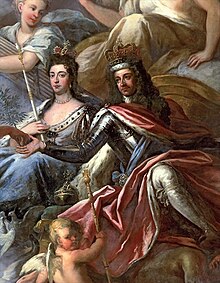William and Mary
The phrase William and Mary usually refers to the coregency over the Kingdoms of England, Scotland and Ireland, of King William III & II and Queen Mary II. Their joint reign began in February 1689, when they were offered the throne by the Parliament of England, replacing James II & VII, Mary's father and William's uncle/father-in-law, who was "deemed to have fled" the country in the Glorious Revolution of 1688. After Mary died in 1694, William ruled alone until his death in 1702. William and Mary were childless and were ultimately succeeded by Mary's younger sister, Anne.

Historic influence
editTo end the Glorious Revolution, William and Mary signed the English Bill of Rights and began a new co-operation between the Parliament and the monarchs, leading to a greater measure of personal liberty and democracy in Britain. This action both signalled the end of several centuries of tension and conflict between the The English Bill of Rights also inspired the English colonists in North America to revolt against the rule of James II and his proposed changes in colonial governance. These colonial revolts occurred in Massachusetts, New York, and Maryland.[1]
See also
editReferences
edit- ^ Page 154 of the 'History of the Town of Plymouth', by James Thacher, recounts this revolution in New England. This book can be searched on Google Books